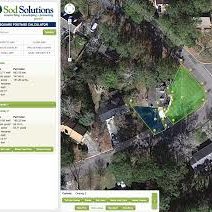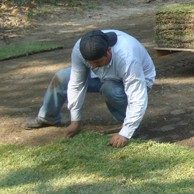How To Properly Install
Installation
Whether you’re doing sod installation on your lawn yourself, or using a professional, it is helpful to know what is involved. Review in detail with your landscaper to avoid dead grass and issues in the future.
When comparing quotes, be sure that both companies are providing the same level of service. If you are looking for professional help for your sod installation, be sure to check out our Where to Buy page for a list of licensed producers, distributors, and installers in your area. We have hand picked some of the most reputable companies in each market.

Step #1
Measure
There are a number of ways to measure your lawn. A great place to start is our Map Based Area Calculator that allows you to click around the perimeter of your property to determine the number of square feet.
You can use multiple overlays to calculate complex shapes with good accuracy. Of course, you can still do it the old fashion way of breaking your lawn down into basic shapes and adding them together.
To ensure full coverage we recommend ordering 5%-10% more than you estimate. Most pallets will be 450-500sqft and this is typically the smallest quantity break that can be ordered. A truckload of grass will vary from 16 to 20 pallets depending on your location.

Step #2
Kill and Remove Old Grass
The next step in sod installation is to kill and remove your old grass. We recommend making an application of RoundUp® or other glyphosate based product, waiting 3-4 days and then making a second application.
Keep in mind that glyphosate is a contact based weed-killer that requires the plant to soak up the active ingredient through its leaves. Avoid applying when the grass is wet or rain is expected or when the grass is freshly cut to maximize effectiveness. When done you should have a fully brown lawn.
Use a sod cutter or roto-tiller to remove the top layer of grass and debris to create a smooth and graded surface for laying new turf. Be sure to mark any existing irrigation heads to avoid breaking them. This layer should be removed from the landscape.

Step #3
Soil Preparation and Grading
“The beauty is in the blades, but the ‘action’ is in the roots,” is a good adage to remember when growing grass. Thus, the value of proper site preparation and soil improvement, before any planting takes place, is that it will be easier for the grass roots to penetrate deeply and evenly upon installation.
Deep roots will make the lawn more drought resistant, a more efficient water and nutrient user and more dense as new grass plant shoots emerge. A dense lawn crowds out weeds and better resists insects and disease.

Step #4
Lay and Roll Your New Lawn
Once you have a nicely graded area ready for sod installation, it is time to have your sod delivered and installed. Be sure to have the grass off the pallet and in your lawn in 48 hours or less with same day preferable. Excessive time on a pallet can quickly dry the grass out.
It is best to use a brick pattern when laying with offsetting seams. Use a landscape edger or machete to cut around corners and at the edges. A handy tip is that most sod harvesters don’t cut straight down, but at a slight angle. You can use this to your advantage to get tighter seams by matching the angle on the pieces to fit together as snugly as possible. Once installed the grass should be rolled for smoothness. The visible seams will go away in a few short weeks.

Step #5
Water, Fertilize, and Mow
During sod installation, it is essential that turf be watered thoroughly. Soak upon installation and water as needed to keep your grass from drying out. The soil should be most 3-4 inches deep. Overwatering for an extended period, however, will severely damage the turf, inducing disease and rotting roots.
It usually takes 7-10 days during the active growing season for the sod to establish, but may take longer during cooler weather. Proper rooting can be checked by lifting a corner of the new sod piece and noting if “white” roots have connected to the ground. Mow the new sod 7-10 days after installation.
Your sod should arrive with a fresh application of fertilizer which will last it for a few weeks. For the first 2-3 weeks after install, try to keep traffic to a minimum to give the roots an opportunity to firmly knit with the soil and ensure that it will remain smooth and level.

